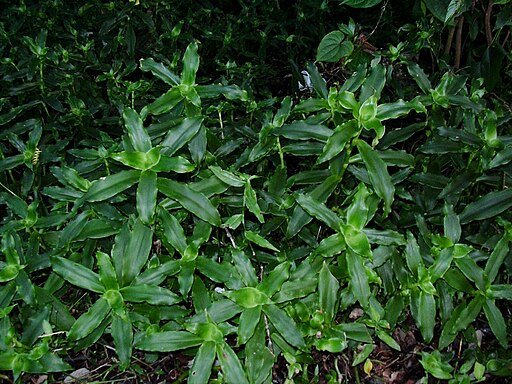Classification System: APG IV
Superregnum: Eukaryota
Regnum: Plantae
Cladus: Angiosperms
Cladus: Monocots
Cladus: Commelinids
Ordo: Commelinaless
Familia: Commelinaceae
Subfamilia: Commelinoideae
Tribus: Tradescantieae
Subtribus: Tradescantiinae
Genus: Callisia
Species: Callisia fragrans
Name
Callisia fragrans (Lindl.) Woodson, Ann. Missouri Bot. Gard. 29: 154. 1942.
Synonyms
Homotypic
Rectanthera fragrans (Lindl.) O.Deg., Fl. Hawaiiensis 62: s.p. 1932.
Spironema fragrans Lindl., Edwards's Bot. Reg. 26: 47. 1840.
Heterotypic
Spironema orthandrum Lindb., Acta Soc. Sci. Fenn. 10: 127. 1871.
Distribution
Native distribution areas:
Continental: Northern America
Regional:Mexico
Mexico Central; Mexico Gulf; Mexico Northeast; Mexico Southeast; Mexico Southwest
References: Brummitt, R.K. 2001. TDWG – World Geographical Scheme for Recording Plant Distributions, 2nd Edition
References
Primary references
Woodson, R.E, 1942. Annals of the Missouri Botanical Garden. St. Louis, MO 29:154. 1942
Links
Govaerts, R. et al. 2019. Callisia fragrans in World Checklist of Selected Plant Families. The Board of Trustees of the Royal Botanic Gardens, Kew. Published online. Accessed: 2019 October 30. Reference page.
International Plant Names Index. 2019. Callisia fragrans. Published online. Accessed: October 30 2019.
Tropicos.org 2019. Callisia fragrans. Missouri Botanical Garden. Published online. Accessed: 30 October 2019.
USDA, ARS, Germplasm Resources Information Network. Callisia fragrans in the Germplasm Resources Information Network (GRIN), U.S. Department of Agriculture Agricultural Research Service. Accessed: 07-Oct-06.
Vernacular names
English: basketplant
Callisia fragrans, commonly known as the basket plant, is a species of the genus Callisia, in the family Commelinaceae.[1]
Description
Close-up of inflorescence, showing the small, white, fragrant flowers
The fleshy stem of the herb grows to a height of 1 metre. 25-centimetre-long leaves become violet if exposed to strong sunlight. Blossoms are white and fragrant.[3][4]
Range and cultivation
The Basket plant is endemic to Mexico, and naturalized in the West Indies, scattered locations in the United States, and a few other places.[2][5] It has been cultivated in many countries as an indoor ornamental since the early 1900s.[6] However, it can be also found growing outdoors in warmer climates in moist, fertile soil. The herb likes partially shaded areas.
Medicinal properties
It has a rich folkloric reputation as an antiviral and antimicrobial plant. Especially in Eastern Europe, its leaves are used for treatment of various skin diseases, burns and joint disorders.[6] An ethanol leaf extract has been shown to effectively inhibit the infection of Vero cells by HSV-1, HSV-2 and an ACV-resistant strain of the latter, in vitro. The ethanol leaf extract, as opposed to an aquatic extract, was however ineffective against VZV.[6] Though the ethanol leaf extract had a lower selectivity index (toxicity vs. effectiveness) than ACV, it was able to inhibit the HSV-2 mutant, and may be less toxic than ACV. Direct interaction with the viruses and blocking of their access to the host cells seems to be involved.[6]
References
"Plants database". United States Department of Agriculture. Retrieved 9 February 2022.
Kew World Checklist of Selected Plant Families
Klaus Kubitzki; H. Huber; P.J. Rudall; P.S. Stevens (1998). Flowering Plants. Monocotyledons: Alismatanae and Commelinanae (except Gramineae). p. 89. ISBN 3-540-64061-4.
"POTENTIAL ENVIRONMENTAL WEEDS IN AUSTRALIA" (PDF). NATIONAL WEEDS PROGRAM. Queensland Department of Natural Resources. Archived from the original (PDF) on 2007-10-10. Retrieved 2011-05-16.
"Ecology and Evolutionary Biology Plant Growth Facilities". University of Connecticut.
Yarmolinsky, Ludmila; Zaccai, Michele; Ben-Shabat, Shimon; Huleihel, Mahmoud (4 June 2010). "Anti-Herpetic Activity of Callissia fragrans and Simmondsia chinensis Leaf Extracts In Vitro". The Open Virology Journal. 4 (1): 57–62. doi:10.2174/1874357901004010057. PMC 2918872. PMID 20700398.
Retrieved from "http://en.wikipedia.org/"
All text is available under the terms of the GNU Free Documentation License


